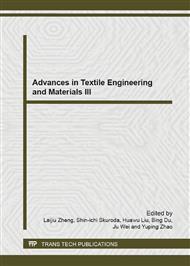p.807
p.811
p.815
p.819
p.823
p.829
p.835
p.841
p.845
Analysis on the Cloud Shoulder Pattern of the Yuan Dynasty Fabrics
Abstract:
The cloud shoulder pattern with four weeping clouds shape commonly used for decorating the parts from collar to shoulder for clothing and shoulder part for blue and white porcelain can be traced back to persimmon calyx pattern of the Han Dynasty. In the Tang Dynasty, the pattern of a four-petal leaf as first went for pattern details change and later advanced into cross flower, developing into the usual pattern decorated on fabrics. Till the Song dynasty, persimmon calyx pattern combined with Ruyi cloud (auspicious cloud) and was applied to architectures. However, the Yuan Dynasty’s shoulder cloud pattern with four weeping clouds shape used for decorating shoulders of clothing or porcelain was generated from combination of Ruyi cloud persimmon calyx pattern and “Bo” which was used to keep necks from wind and sand for Nomads in northern part of the country and developed into the cloud shoulder pattern focusing on decorating the shoulder of clothing and widely was used for nobles’ clothing. Gradually, the pattern was used for decorating crafts such as blue and white porcelain and gold and silver ware in the Yuan Dynasty. The cloud shoulder pattern spread from nobles to folks and was popular for decoration.
Info:
Periodical:
Pages:
823-828
Citation:
Online since:
September 2013
Authors:
Keywords:
Price:
Сopyright:
© 2013 Trans Tech Publications Ltd. All Rights Reserved
Share:
Citation:


